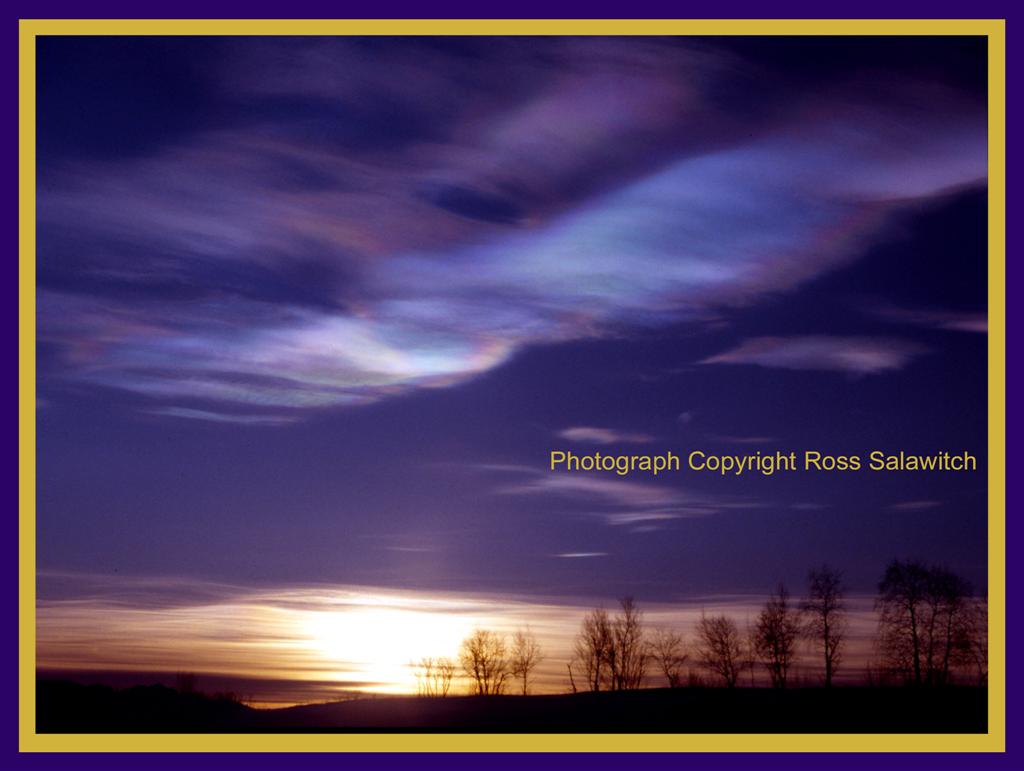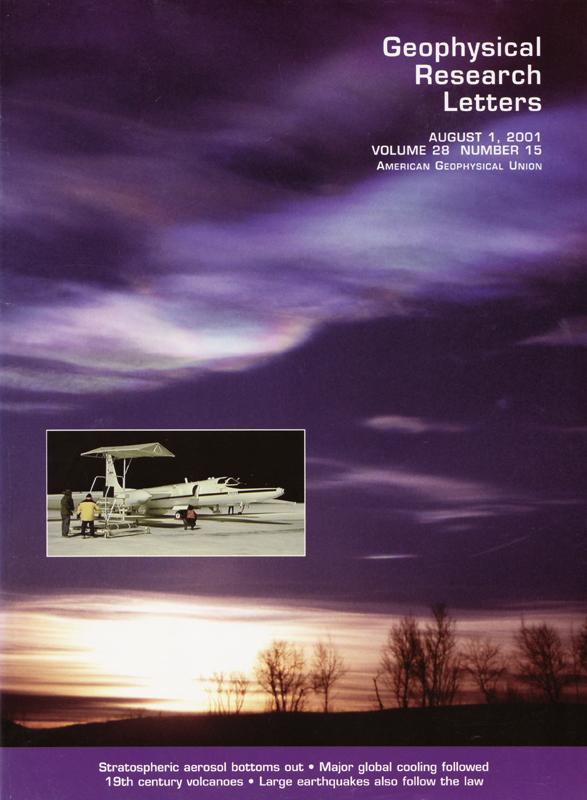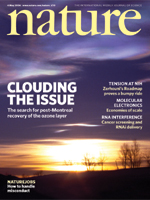
| Home |
| Research |
| Group Members |
| Publications |
| Classes Taught |
| Prospective Students |
| Directions to CSS Bldg |
| Campus Map |
Polar Stratospheric Cloud
Clouds such as those pictured above exist only at very high altitude (~70,000 ft) within Earth's stratosphere. Clouds do not normally form in the stratosphere due to its extreme dryness. During winter at high latitudes, however, stratospheric temperature sometimes becomes low enough to promote formation of clouds. The colorful appearance of these clouds results from the presence of small particles of about the same size that diffract sunlight in a similar manner. The clouds often remain fully illuminated for about 20 minutes following sunset at the ground because of their high altitude, resulting in a spectacular appearance of the twilight sky. A good gauge of the altitude of these clouds is their illumination pattern as the sun rises or sets at the surface, a fact that has been long known by Scandinavian scientists. The modern description of polar stratospheric clouds began with satellite measurements obtained in the early 1980s by M. Pat McCormick of NASA Langley Research Center.
Called "Mother of Pearl" by Scandinavians due to their iridescent appearance, these clouds are composed of mixtures of naturally occurring water and nitric acid. Chemical reactions that occur on the surface of these clouds result in a remarkable transformation of stratospheric composition. Chlorine that is supplied to the stratosphere mainly from industrial sources is converted from relatively un-reactive forms to other compounds that are highly reactive with ozone, leading to substantial ozone depletion. It is a great irony that these beautiful clouds participate in a chain of events that results in the depletion of stratospheric ozone by man-made chlorine. Reactions that take place on the surface of these clouds are responsible for the Antarctic Ozone Hole as well as significant loss of ozone in the Arctic during cold stratospheric winters.
A compelling account of the relationship between polar stratospheric clouds and ozone depletion is provided in an article entitled The Hole Story, written by Gabrielle Walker, that appeared in the 25 March 2000 issue of New Scientist. A scientific review of the relation between polar stratospheric clouds, chlorofluorocarbons, and ozone depletion is given in the report of a meeting held the summer of 2008 in Cambridge, England to review the The Role of Halogen Chemistry in Polar Stratospheric Ozone Depletion.
Although clouds such as these are composed of naturally occurring atmospheric compounds, there is concern that changes in stratospheric temperature brought on by climate change could lead to more of these clouds, and larger levels of ozone depletion, in the future. In 1998, I wrote a News and Views piece on this topic for Nature, which accompanied a journal article led by Drew Shindell. More recently, Markus Rex, myself, and numerous other colleagues have written on this topic in Geophysical Research Letters, in both 2004 and 2006.
The particular photograph shown above was taken by Ross Salawitch in Kiruna, Sweden on 27 January 2000 during the NASA SOLVE polar ozone campaign. The exposure was made on Kodak Ektachrome slide film, using a Minolta X-370 camera placed on a tripod just outside of the Arena Arctica research hangar. It was exceedingly cold, both at the ground and in the stratosphere, on the day this image was recorded. Slide film is particularly sensitive to subtle gradations of sky color. The image was digitized using an HP slide scanner that is capable of extracting extremely high resolution, rendering a final image that posses a continuous color palette without pixilation. It would have been exceedingly difficult to obtain either property using a digital camera circa 2000.
This photograph and others shot the same day have been used in stories on polar ozone depletion in numerous magazines and books. These images have also been featured on the cover of the scientific journals Geophysical Research Letters and Nature:
Please contact Ross Salawitch at rjs "@" atmos dot umd dot edu) if you would like a high resolution version of any of these photographs.
For more information about the relation between polar stratospheric clouds and ozone loss, please see the excellent "Twenty Questions and Answers About the Ozone Layer: 2006 Update" document led by David Fahey of NOAA ESRL.
Department of Atmospheric and Oceanic Science College of Computer, Mathematical, and Natural Sciences
Department of Chemistry and Biochemistry The University of Maryland Newsdesk
Earth System Science Interdisciplinary Center The University of Maryland


